The covering for the roof is made with organic, mineral materials or made of metal. Roofing materials of the first group include bitumen and polymer varieties, and the second category includes slate tiles, cement-sand, ceramic tiles, slate. Modern mineral coatings serve for a long time, do not rot, but the flooring suffers from extreme heat and cold. Bituminous types of building materials age quickly under the influence of the sun.
Varieties of modern sheet roofing
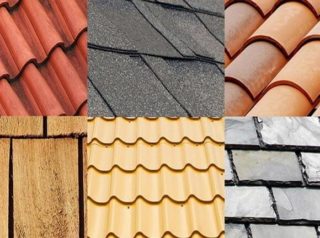
The material is commercially available as separate sheets of different lengths and widths. Elements are produced flat or profiled in the form of waves. Corrugation can be square, trapezoidal and semicircular. Attach to the roof with self-tapping screws, nails. The installation technology is simple and does not require the use of special equipment; hand tools are used.
Sheet building materials provide the strength of the roof covering, but some types conduct noise from rain and birds, so they put an insulating layer. Previously, unpainted black roofing steel was used, now they are galvanized.
Copper sheets decorate the house, because they have a beautiful look. The material is rarely used due to the high price. Copper is sold in the form of a roll strip 67 cm wide, 06 - 0.8 mm thick. The roof for the roof is made of zinc (called zinc-titanium), which is an alloy with small additions of titanium and copper for ductility when cooled.
Metal tile
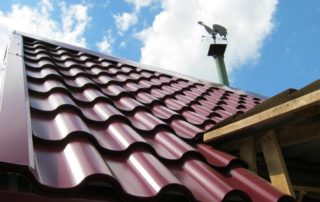
Made from galvanized steel, which is rolled and stamped to shape into individual tile elements. After that, the sheets are coated with a polymer compound to additionally protect the roof for the roof from corrosion.
Plants produce strips:
- up to 6 meters long, and up to 8 meters on request;
- width is 1120 - 1180 mm;
- the thickness ranges from 0.35 to 0.6 mm;
- sheet weight - within 4 - 9 kg.
Lightweight material does not require a powerful rafter system and metal trusses; it is mounted on roofs with an angle of inclination greater than 15 °. The strips are overlapped with an overlap of the width of one wave; for fastening, self-tapping screws with washer rubber gaskets are taken.
Sheets are selected taking into account the required stiffness. For example, a metal profile with a thickness of 0.035 - 0.4 mm is deformed with little effort. Such sheets are used for temporary roofing of the roof, canopies for pavilions. Thin stripes are placed in short elements (up to 3 m), the slope of the slopes is increased to 40 °.
Asbestos-cement slate
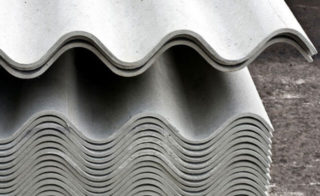
Refers to cheap coatings, popular at one time, but gradually replaced from use by new types of coatings. Slate is made from asbestos-cement mortar, which contains 15% asbestos and 85% cement. Sheets are distinguished by geometric dimensions, the number of waves and their height.
Slate elements parameters:
- width 800 - 1130 mm, length 1200 - 1750 mm;
- sheet weighs 9 - 15 kg;
- there are 6, 7, 8 waves on the panel.
The building material serves for a long time under normal operating conditions, but it is fragile and can crack with mechanical shock or walking on the roof during the repair period.
Slate modifications:
- ordinary wavy slate - VO, size 800 x 1200 mm, thickness 5.5 mm;
- reinforced profile - VU, size 800 x 1750 and 800 x 2000 mm, thickness 8 mm;
- unified slate - HC, sizes as VU and VO.
They are used for a roof slope of 12 - 60 °, fastened to the lathing with nails for slate or use ordinary hardware with gaskets. More often used for outbuildings and small buildings.
Ondulin
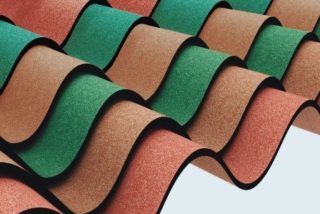
It is made from cellulose, the raw material belongs to environmentally friendly types. The mass is pressed to shape and heated in a chamber to + 120 ° C. Externally, the building material resembles slate, but differs from it in characteristics. The dried workpieces are impregnated with bitumen and painted with polymer compositions. Ondulin does not get wet and does not conduct water due to special treatment.
Lightweight material saves money when constructing a supporting roof frame. A continuous crate is placed under the ondulin, chipboard and OSB plates are used. Its flexibility allows it to be mounted on curved roofs.
Coating advantages:
- water resistance;
- hygiene, safety;
- easy installation;
- ease;
- simple cutting and processing;
- noiselessness.
The disadvantages of ondulin include flammability. During the heat, an unpleasant bituminous odor may appear. From the sun's rays it changes color, while fading in places.
Seam roof
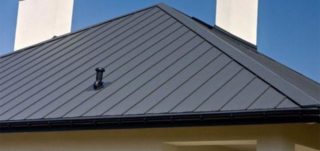
The material is steel strips with a smooth surface as a roof cover. On the edges there are locks, which are called seams. There are recumbent, single, standing and double types of connectors. They produce sheets without coating (galvanized) and with a polymer layer on the surface. Often used for hangar roofs, since the building material has spatial flexibility.
Locks are crimped with special machines for fixing joints. Installation on slopes is carried out in parts. On the ground, a map is made of several flat elements, they are connected along the length with standing seams, and recumbent folds are made in width. Part of the coating is placed on top and fixed to the bars with narrow steel strips (clamps). Seam roofing is made on roofs with a slope of 14 °, and at a lower steepness, a solid base is made for steel strips.
The coating is durable, has reliable protection, it is often used in the reconstruction and repair of old buildings.
Corrugated board
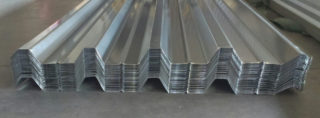
Roofing material has similar properties to metal shingles. The technology for the production of two metal profiles is almost the same, but stamping is not used for corrugated board, only rolling on machine tools is used. There is no relief on the surface, there are only longitudinal undulating bends. The corrugation is round, square.
For the roof, I produce grades of profiled sheet:
- NS - profiled sheet for universal use with increased rigidity;
- H - reinforced sheets, can be used on flat roof surfaces;
- C - mounted on roofs with a slight slope and walls;
- PC - an economical option, put on visors and canopies of a small area;
- PG - sheets are bent with a certain radius for arched roofing and domed hangars.
Coating on both sides with zinc-alumina or zinc is widespread. Acrylates, plastic and polyester films, polyurethane layers are used as protection.
Roofing piece materials and their characteristics
Roofing materials are produced in separate small-sized elements, which form a common canvas after laying in a certain order. Piece links benefit from the fact that there is almost no waste during installation. The surface of small-sized elements has a beautiful appearance.
The group includes varieties:
- ceramic tiles;
- cement-sand tiles;
- shale materials;
- composite type;
- soft bituminous appearance.
Manufacturers produce ridge and end parts for all types of roofing materials. The links provide the best fit, tightness and strength of connections. For the arrangement of joints around the pipes, special strips are placed, protection for the ends is provided, there are elements of wind boards and cornices. Piece links require a solid base, a vapor barrier, waterproofing and insulation. For each type of tiles, its own installation technology has been developed.
Ceramic roof tiles
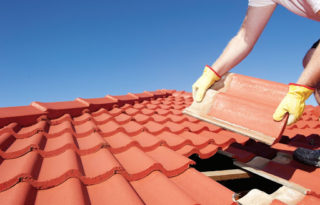
The brick reddish color is obtained by firing the clay at high temperatures. The tiles are 30 cm long, the tiles weigh approximately 4 kg, therefore, a rafter system of increased strength is arranged. Ceramic tile roofing is installed on pitched surfaces with a slope in the range of 25 - 60 °. It is better to order the entire volume of tiles at once in order to get it from one batch and not violate the uniformity of the shade.
The number is calculated taking into account the dimensions of the slope, tiles, overlap and roof slope:
- slope up to 25-45 ° - make an overlap of 10 cm;
- steepness from 45 ° - allow an approach of 4.5 cm.
For the lathing, choose bars 50 x 50 cm, put them in increments of 60 - 90 cm. Each tile has holes for nailing into the base. The installation is started from the bottom, the upper tile is brought to the lower one so that the surface looks like scales. The ridge is mounted last.
Cement-sand
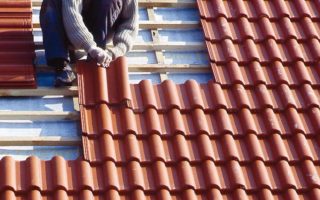
The tile is a cheap analogue of ceramic tiles, but has different properties. They produce ordinary, half tiles. The tiles are available in brown, red and dark brown colors.
In addition to the main links, additional parts are produced, as a result of the use of which it is possible to cover the roof of varying complexity:
- ridge;
- starting;
- spinal;
- hip.
Dimensions, weight and technical characteristics correspond to the normative values given in the tables of the handbooks. The material belongs to frost-resistant species and does not allow moisture to pass through. A shingle made of cement with sand can withstand up to 100 freezing and thawing periods without destruction and deformation. More than three defects are not allowed on the surface, and the curvature should not be more than 2 mm.
For the lathing, a beam of 30 x 50 mm is used, and the step is calculated by the type of tiles (30 - 40 cm). A lifting bar is attached to the bottom of the crate to level the position of the first tile with the rest of the elements.
Shale
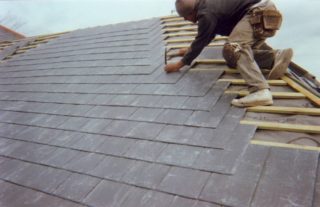
Roofing from slate tiles is considered an expensive type, since the material is of natural origin (clay slate) and is processed manually.
As a result, the dimensions of the tiles are obtained:
- width - 15 - 30 cm;
- length - 20 - 60 cm;
- thickness 4 - 9 mm;
- element weight - from 25 kg / m2.
When laying, each link is fixed with 2 - 3 nails, while a slope of 25 ° is recommended. A durable coating lasts up to 150 - 170 years if the installation instructions are fully followed. More often than others, tiles with a size of 20 x 25 cm are used, for a smaller slope they take 30 x 60 cm.The standard shape is in the form of a square and a rectangle, but round or oval types are produced on request.
They produce cheap analogs of slate tiles from artificial raw materials, which are not inferior to the original version, but are sold at a lower cost.
Composite
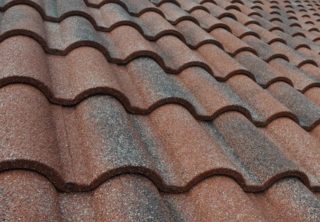
The building material combines the qualities of metal and ceramic tiles. The plates are collected from several layers; for the roof, they all have a positive value. It is based on steel, additional layers are made with natural granular stone spraying, zinc-alumina, anti-shedding glaze. Alumozinc is a compound of silicon, zinc, aluminum for corrosion protection.
The difference from metal tiles is that such products do not have a noise effect and do not require sound insulation. They are used to cover the attic of any square. Composite shingles are not afraid of temperature extremes and serve for a long time in frosty climates (40 - 50 years). Tiles are placed on a lath of wooden slats with a cross section of 30 x 50 mm, which are installed with an interval of 40 - 50 cm.
Soft bituminous
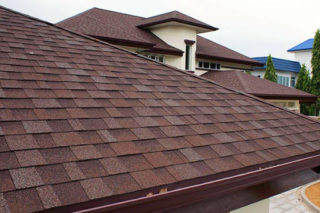
The modern look of fiberglass roofing. The base is impregnated with bitumen and covered with grains of basalt. They are produced in various shapes, there are rectangular, rounded, different colors. A solid base is placed under the building material, and the products are glued to it and additionally fixed with nails. The bottom layer is covered with mastic, which is heated before gluing.
The permissible roof slope is taken from 11 °. Soft tiles serve for about 70 years without loss of quality. Does not make noise from falling drops and movement of birds, it has a presentable appearance. Condensation does not appear on the inside and outside, the material resists destruction from atmospheric action. Flexible elements are easily installed on dome and arched structures.
Advantages and disadvantages
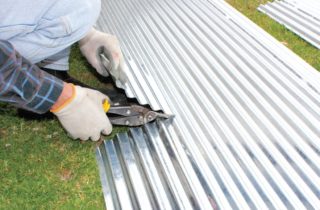
Each type has its own positive and negative qualities, which differ from other types of coating. For example, a bituminous soft roof is placed only on a flat area and fixed with nails made of galvanized metal. For her, a lining carpet must be installed, without which flaws and seams of the preparatory layer appear.
Composite shingles are distinguished by their multi-layer structure, reproduce the appearance of natural shingles, but are cheaper and more stable in terms of fragility. The disadvantage is the high cost of the material and the inconvenience of repairing the flooring if necessary.
The metal tile is lightweight, available in different colors and shapes, but it also has disadvantages:
- low resistance to corrosion in places of cutting (due to violation of protection);
- when cutting into triangular and trapezoidal pieces, a lot of waste is obtained.
The corrugated board serves for a long time, is inexpensive, does not burn, but reinforced options are installed for flat roofs. Slate emits harmful substances, is fragile, requires painting after installation to extend its service life.
Factors to consider when choosing roofing materials
Take into account the magnitude of the roof loads. For example, the wind force depends on the side of the slope (in each region there is a prevailing direction of flows) and the slope. The same parameters affect the weight of the snow, since from a sloping roof the snow moves downward more slowly and accumulates in a large mass.
The design decision depends on the wishes of the owner, but it is important to take into account the technical properties of the roof deck (strength, durability, flammability). Structures of complex shapes need to be lined with bending materials, and for a flat roof, use a reinforced profiled sheet.
Operated roofs are covered with a material with a high bearing capacity, after three- or four-layer bitumen, paving slabs are laid for strength.








